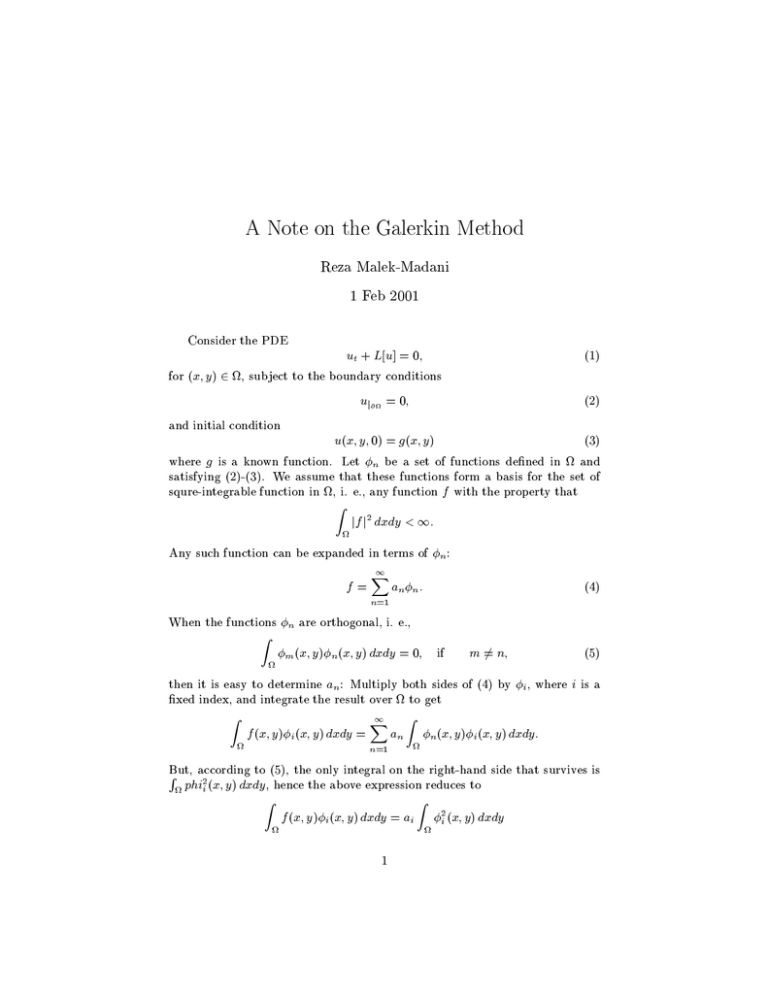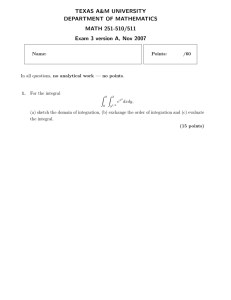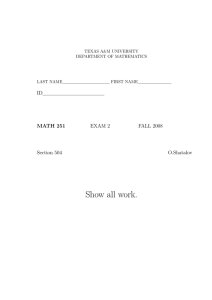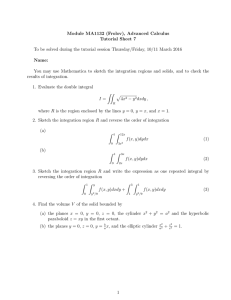Document 11102796
advertisement

A Note on the Galerkin Method Reza Malek-Madani 1 Feb 2001 Consider the PDE ut + L[u] = 0; (1) for (x; y) 2 , subject to the boundary conditions u @ = 0; (2) and initial condition u(x; y; 0) = g(x; y) (3) where g is a known function. Let n be a set of functions dened in and satisfying (2)-(3). We assume that these functions form a basis for the set of squre-integrable function in , i. e., any function f with the property that j Z jf j2 dxdy < 1: Any such function can be expanded in terms of n : f= 1 X n=1 an n : (4) When the functions n are orthogonal, i. e., Z m (x; y)n (x; y) dxdy = 0; if m 6= n; (5) then it is easy to determine an : Multiply both sides of (4) by i , where i is a xed index, and integrate the result over to get Z f (x; y)i (x; y) dxdy = 1 X n=1 an Z n (x; y)i (x; y) dxdy: But, according to (5), the only integral on the right-hand side that survives is R 2 phi i (x; y ) dxdy , hence the above expression reduces to Z f (x; y)i (x; y) dxdy = ai 1 Z 2i (x; y) dxdy from which one computes ai = R fR(x; y )i (x; y ) dxdy : 2 i (x; y ) dxdy (6) Formula (6) is the familiar formula of Fourier. Let's use the short-hand notation (f; g) for the integral of the product of f and g, i. e., Z (f; g) = f (x; y)g(x; y) dxdy: (7) In terms of (7), the Fourier formula (6) can be written as ai = ((f;;i )) ; i = 1; 2; ::: (8) i i Now let's go back to our original initial-boundary value problem. The Galerkin method suggests seeking a solution of (1), (2), (3) in the form u(x; y; t) = X an (t)n (x; y) (9) for a basis n which satises the boundary condition in (2). Since the ansatz (2) is to be a solution of the PDE, it must satisfy that equation, so we substitute it into (1) to get 1 X n=1 an (t)n (x; y) + L[ 0 X n=1 an (t)n (x; y)] = 0: We next multiply both sides of this equation by i , for a xed i and integrate over . Using the notation in (7) we have 1 X n=1 an (t)(n ; i ) + (L[ 0 1 X n=1 an n ]; i ] = 0; i = 1; 2; ::: (10) Also, after evaluating (9) at t = 0 and using the information in (3), we have g(x; y) = 1 X n=1 an (0)n (x; y): We multiply this equation by i and integrate over to get (g; i ) = 1 X n=1 an (0)(n ; i ); i = 1; 2; ::: (11) Note that because g and are known functions, all of the integrals of the form (g; i ) and (n ; i ) can be computed, often rather easily and inexpensively. This 2 way, our initial-boundary value problem (1), (2), (3) is redeuced to a system of ininitely many ordinary dierential equations given by (10) with initial data given in (11). A large body of the mathematics of the latter half of the twentieth century has been dedicated to understanding under what conditions our initialboundary value problem is equivalent to the ininite system of ODEs described above. One of the most desirable aspects of the Galerkin method is that it applies to nonlinear problems as well as to linear problems. Another desiable property is the ease with which one can implement this technique on a computer, especially when the geometry of the domain is simple. The implementation is particularly simple when the basis functions are orthogonal. The following examples illustrate these points. 1 Example 1: Heat Equation Let's consider the case when is a unit square and L[u] = ,u: Then (1) becomes ut , u = 0: (12) Let mn = sin nx sin ny: (13) (why do we introduce mn in place of n ?) Note that mn already satises the zero boundary condition on the boundary of the unit square. The ansatz in (9) takes the form u(x; y; t) = 1 1 X X n=1 m=1 amn (t) sin nx sin my: (14) It is easy to show that mn are orthogonal, i.e., Z 1Z 1 0 0 sin nx sin my sin ix sin jy dxdy = 0 if i 6= n and j 6= m. Substituting (14) into (12) yields 1 1 X X m=1 n=1 amn (t)mn , 0 1 1 X X m=1 n=1 amn mn = 0: Multiply the above equation by ij and integrate over to get 1 1 X X m=1 n=1 cmnij amn (t) , 0 1 1 X X m=1 n=1 3 dmnij amn (t) = 0; (15) where cmnij = Z 1Z 1 0 0 Z sin mx sin ny sin ix sin jy dxdy and 1Z 1 dmnij = (sin mx sin ny) sin ix sin jy dxdy: 0 0 It is easy to compute the above integrals using the2 orthogonality of the sine functions. In fact cmnij = 41 mi nj and dmnij = , m 4+n2 mi nj . Let u(x; y; 0) = g(x; y) (16) dene the initial state of u. The dierential equations in (15) are supplemented with the initial data as described in (11). In practice, we replace 1 by M in (16) and (11) and solve the resulting M 2 ODEs numerically to get an approximate solution of our problem. The following program in Mathematica will do the job. 2 Example 2: Reaction Diusion Equation Consider the PDE ut = u(1 , u) + u (17) in the unit square. We choose the same basis function and ansatz as in Example 1 (see (14). Now substitute (14) into (17) to get 1 1 X X m=1 n=1 amn (t)mn = 0 1 1 X X m=1 n=1 amn (t)mn , 1 1 1 1 X X X X m=1 n=1 k=1 l=1 1 1 X X amn (t)akl (t)mn kl + m=1 n=1 amn mn : The quadruple sum in the above expression is due to the u2 in (17). As before we multiply this equation by ij and integrate over to get 1 1 X X bmnij amn (t) = 1 1 X X cmnij amn (t), 1 1 1 1 X X X X 1 1 X X dmnklij amn (t)akl (t)+ emnij amn (t) m=1 n=1 m=1 n=1 m=1 n=1 k=1 l=1 m=1 n=1 (18) where the coecients b, c, d and e involve the various integrals of mn . The above system is considerably dierent from the one we get from the heat equation in that the latter is a nonlinear system. This fact presents a challenge to any computing system when we replace 1 with M 2 since we are often interested in the large time (steady-state) behavior of this problem so the M 2 ODEs need to be integrated over a long time interval. The following Mathematica program shows how one handles this problem when M is in the range of 5 to 10. 0 4





